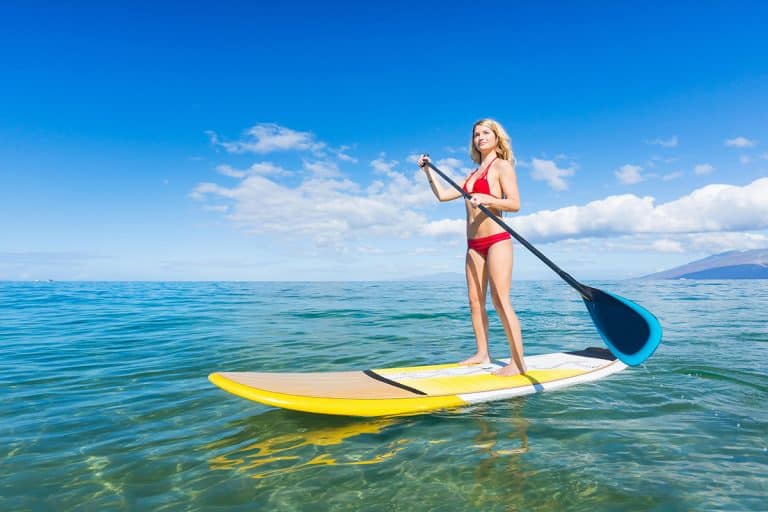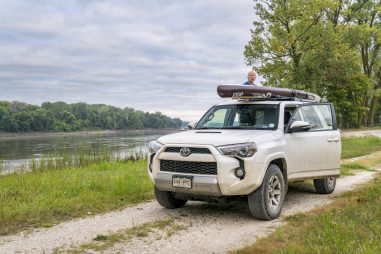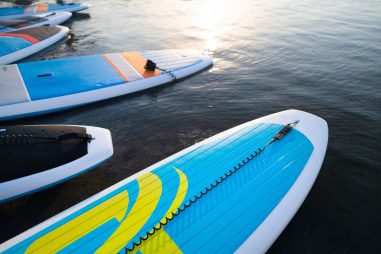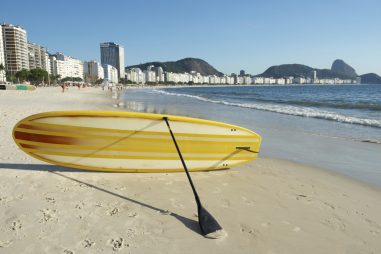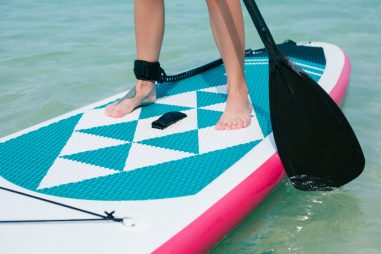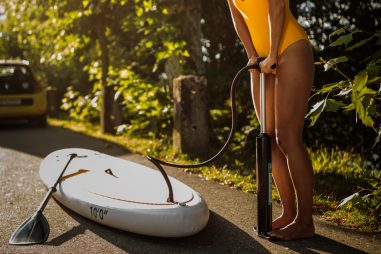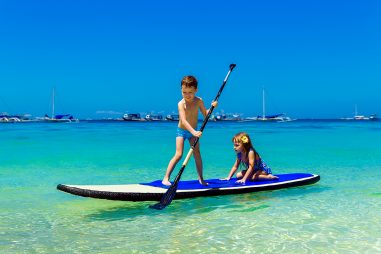Stand up paddle boarding may be a no-fuss sport but choosing the right equipment needs a lot more of your attention. Since the paddle board will be your “vehicle” in the water, it is very important that you choose the best one that will serve your riding goals and style and is perfect for your body dimensions. Read on to so you can be guided on how to choose the perfect paddle board for you.
What Should I Look for in a Stand Up Paddle Board?
If you want are on the lookout for your first paddle board, or if you just want an upgrade, there are several factors that you should take into considerations. While we do have different riding styles and riding goals, these deciding factors when buying a stand up paddle board are pretty universal.
- The shape of the board: There are two general shapes of the hull of a stand up paddle board: a planing hull or a displacement hull. Now, as innovations continue to take on the sport, some paddle boards have a hybrid of these two hull shapes, but most of the boards in the market either have a planing hull or a displacement hull. You should consider the shape of the hull of your board because they have an effect on how your board performs. While both hull shapes are great for beginners, they support different riding styles.
- Planing Hull: This shape is closest to that of a surfboard. The hull is designed to be flat and wide, and it is great for leisure paddling, surfing, whitewater paddling, and stand up paddle yoga. Boards with planing hulls offer great maneuverability.
- Displacement Hull: Boards with displacement hulls are easy to spot because they have a pointed bow, much like the shape of the front end of a kayak or a canoe. Due to the shape of the bow, this hull shape offers efficiency, speed, and stability. Boards with displacement hulls are great for long distance paddling, fitness paddling, racing, and touring.
- The volume of the board and weight capacity: The volume of the board and its weight capacity are two of the most important factors to take into consideration because it affects your stability and your ability to wade into the water. The volume of a board is expressed in liters, and it indicates how much weight it can carry while floating. Note that the higher the volume of the board, the more weight it can carry. You should also take into consideration the rider weight capacity because the weight of the rider should be within the weight that the board can carry. Your weight (plus all the gear and supplies that you will be bringing with you) should be suitable to the volume of the board; otherwise, it will ride lower, and you will have a hard time paddling.
- Length: Length is another important factor when choosing your board because the length determines how the board performs in the water. Longer boards are generally faster, and shorter boards are easier to maneuver. The length of your board should also serve your riding goals.
- Short boards: There are paddle boards that are less than 10 feet in length. Most short boards are made with planing hulls which make them great for surfing. They are also the most recommended for children.
- Medium boards: These are paddle boards that are between 10 to 12 feet. Most medium boards are made with planing hulls, but there are also those that are made with displacement hulls. Medium boards are generally great for all kinds of paddling activities, especially stand up paddle yoga.
- Long boards: These are paddle boards that are 12 feet and 6 inches and longer. Most long boards are made with displacement hulls, and they offer more straight tracking and speed as compared to short and medium boards. Long paddle boards are great for long distance paddling, touring, and racing.
- Width: Generally, wider boards are more stable; however, this kind of board can be slower. You should pick a board whose width is just perfect for your body dimensions because if a board is too wide for you, then you would have a hard time paddling. Paddle boards are made in varying widths to cater to different riding styles and goals, and they range from 25 to 36 inches. When choosing the right width for you, you should consider your riding style, your body type, and your skill level.
- Thickness: The thickness of your paddle board is a huge factor in the board’s volume and weight capacity. Generally, the thicker the board, the more volume it has, and if a board has a higher volume, then it can support more weight.
- Board construction: There are two kinds of board constructions: solid (hardboard) and inflatable. These two are very different, and they have their own pros and cons.
- Solid stand up paddle board: Your solid board can be made of different materials. Most boards are made with fiberglass, epoxy, and EPS foam core. Others are made with carbon fiber or plastic, and some even use wood. Solid boards allow for the best performance on the water because they offer more speed, efficiency, stability, and they move smoother. Aside from that, solid boards are made in varying sizes, so it is easier to pick the best for you.
- Inflatable stand up paddle board: Your inflatable board is usually made with a PVC exterior. It also has drop-stitch construction. When you buy an inflatable paddle board, it usually comes with a pump and a storage bag. Inflatable paddle boards are more portable, and traveling is easier with this kind of board. It is also great for paddling whitewater and stand up paddle yoga.
- Fins: The fins may be the smallest part of your board, but they are very important, and it is another factor to consider when buying a new paddle board. There are different fin setups to try depending on your riding style, but generally, larger fins track straighter and offer more stability. On the other hand, boards with smaller fins are easier to maneuver.
How Much Do Stand Up Paddle Boards Cost?
Paddle boards are priced differently due to many different reasons, such as the combination of materials used, leash, fin, and other accessories. Generally, inflatable paddle boards are cheaper than solid or hardboard ones. They can go for as cheap as 350 dollars to as expensive as 1,700 dollars, depending on the materials used, the durability, and special offerings of the board.
On the other hand, epoxy paddle boards are known to be the most expensive type of paddle board. The price usually starts at 700 dollars up to a whopping 2,000 dollars. They cost this much because of the materials used. Aside from that, the shipment of these boards is more difficult than inflatable ones.
Why Are Stand Up Paddle Boards So Expensive?
There are many different reasons why stand up paddle boards cost the way they do (and yes, we mean, expensive). When you buy a stand up paddle board, you would be paying for the quality of the materials used, the construction of the board (and the technologies used), the durability of the board, its weight capacity, the size and overall performance of the board, and the accessories that come with the board.
Looking at the materials used alone, it is understandable why solid board comes with a hefty price tag. Solid boards are usually made with fiberglass or epoxy, while inflatable paddle boards are usually made with layered PVC with EVA deck pads and drop-stitch technology.
When you buy a board, you don’t only pay for the board itself but for the many years that it can serve you.
How Much Should I Spend on a Stand Up Paddle Board?
The amount of money that you should spend on a stand up paddle board will depend on what you are looking for and who you are as a stand-up paddle boarder. If you like speed, efficiency, and more power as you paddle, then prepare to spend anything between 700 dollars to 2,000 dollars for a solid board. The price does look steep, but if you are thinking of going pro or at least getting serious with the sport, then a board in that price range can serve you years.
If you are into traveling and being able to use your stand up paddle board as you cross borders, then prepare to spend at least 350 dollars or more for a better quality inflatable paddle board.
The prices for both solid and inflatable paddle boards are high, and new ones do come with hefty price tags because, at the end of the day, you are also paying for the materials used, the durability, and the accessories. But you don’t need to buy a new one if it is way over budget. You can opt to look for a secondhand paddle board in good condition.
Who Makes the Best Stand Up Paddle Board?
If you have no idea what stand up paddle board to get, you can start by reading up on some of the best paddle board brands that pro paddle boarders vouch for. Do note that some of these brands can be rather pricey since they have been in the paddle board-making business for so long that their name speaks for the quality of their boards.
In no particular order, here are some of the best stand up paddle board brands that you might want to check out.
- Stand on Liquid: Stand on Liquid has been in the paddle board-making business for more than ten years, and they are known for the affordability, quality, and durability of their boards. They used to just focus on the construction of paddle boards, but soon enough, they ventured out into designing and manufacturing sports accessories and paddle board paddles. Stand on Liquid carries many different sizes of paddle boards which ensures that you will find the perfect one for you regardless of your body dimensions and skill level. For starters, you can check out Stand on Liquid Good Vibes Superlite and the Namaste 10′ Inflatable Yoga Paddle Board, which are two of their best models.
- Pau Hana: Pau Hana is known for manufacturing hybrid boards. Paddle boarders can vouch for their boards that are a combination of fiberglass and foam. Pau Hana is known for the affordability of its fiberglass boards and their exceptional construction. Experts often describe Pau Hana as the best boards for beginners or those switching from inflatable to hardboards. For starters, you can check out some of Pau Hana’s best models, including Big EZ Hawaiian Ai, Calypso All-Around SUP, and Endurance Air Touring Board. If you want to try an inflatable board from Pau Hana, you can check out Moon Mist TPU Inflatable SUP.
- Boardworks Surf: Often described as UK and USA’s most trusted soft-top surfboard company, Boardworks Surf was originally known for manufacturing top of the line surfboards and beach accessories. It soon ventured out into catering to the needs of the growing paddle board population, and today it uses different technologies to manufacture paddle boards that both pro and beginner paddle boards can ride. Boardworks Surf is known for its affordability and for this extensive product line up. It’s a one-stop-shop that you can check out for nearly all your beach, surfing, and paddling needs.
- BOTE Board: BOTE Board is popular in many countries in the world, including the UK, USA, and Australia. The company launched in 2008, and it has continuously maintained its rightful place in the top paddle board brands in the world. BOTE Board carries a wide variety of paddle boards which ensures that you can find the perfect one for you. They also carry products for other paddling activities like kayaking and surfing.
- GoPlus: GoPlus is famous for professional and beginner paddle boarders for the unique features of their boards and their sleek designs. They are also very affordable, which makes them the first choice for surf schools. GoPlus also carries a wide variety of products that paddle boarders of all skill levels can ride. The company ensures that its paddle boards are only made with the latest technologies and the safest and highest-quality materials. For starters, you can check out GoPlus iSUP 11, which is their most famous model in the market.
- Connelly: Connelly was pretty much born out of love of the ocean. The founder of the company is known to be a passionate surfer who ventured out into manufacturing well-designed and powerful surfboards. Connelly boards are unlike other boards because they are made with unbeatable attention to detail. Connelly also carries a wide range of products that will be perfect for paddle boarders of any age, body dimensions, and skill levels. Connelly stand up paddle boards can be spotted in most of the national and international competitions, which speaks up for its quality and overall exceptional performance.
- Bluefin: Bluefin is known for manufacturing paddle boards that are perfect for both beginners and professional paddle boarders. Bluefin uses technologies that no other companies use, such as patented FutureFlex technology and customized PE applications. Bluefin believes in innovation, and they design their boards to have full and maximum functionality. For starters, you can check out Cruise Carbon which is Bluefins’s most famous, best-selling, and award-winning model.
- KIALOA: A known Hawaiian brand, KIALOA is praised for manufacturing high-performance surf boards. KIALOA is also one of the best brands, according to many paddle boarders all around the world. According to them, the company is making great use of the combination of modern technologies. Their boards are also known for their superior durability. If you want to try out KIALOA boards, you can start with the Napali II Fusion and the Napali II Inflatable.
- iROCKER: iROCKER is another company that was born out of the love of the ocean. This famous brand is known for its high-quality and innovative boards. iROCKER boards also make appearances in many national and international competitions, proving just how much paddle boarders trust the brand and its products. iROCKER is also known to carry products that all paddle boarders can ride.
- Bay Sports: Bay Sports prides itself on using only the most environment-friendly materials. They are known to support sustainability and innovation, and it shows in their well-constructed high-quality boards. Apart from being eco-friendly, Bay Sports also uses its patented sandwich blank conduction, which results in durable and sturdy boards. The company also uses other modern technologies, including parabolic rail construction, lightweight EPS core, and Entropy bio-resin hot coat.
- Thurso: Thurso has been in the market since the 2000s, which adds to its credibility. Today, they are one of the companies the paddle boarders go to for all their needs. Thurso offers a wide variety of products that suits both beginner and professional paddle boarders. The company is also known for its highly sturdy and durable boards and their innovative designs.
Are Stand Up Paddle Boards Inflatable?
There are inflatable stand up paddle boards that you can buy. They usually come with a pump for inflating it, a storage bag, and some accessories. Inflatable stand up paddle boards retail at around 350 to 1,700 dollars depending on the construction and the materials used.
There are several reasons why both beginner and expert paddle boarders go for inflatable paddle boards. For one, they are great if you want to travel around and experience the beauty of nature everywhere with your paddle board. Inflatable stand up paddle boards are very portable and are easier to carry and store compared to hardboards.
Aside from that, inflatable paddle boards are exceptionally durable. They are usually made with military grade material that can withstand any and all harsh elements. Inflatable paddle boards also have a softer deck which makes standing on them for long periods of time less tiring.
What Is a Stand Up Paddle Board Made of?
There are different materials that are being used for the construction of both hardboards and inflatable stand up paddle boards. The outer layer of an inflatable stand up paddle board is made with military grade PVC material. And these boards have inflatable cores.
Solid or hardboards are usually made of a combination of different materials. Most hardboards are usually made of a combination of fiberglass and epoxy resin outer layers over foam cores. Some even have hollow wood cores. You should take into consideration the materials used on your chosen paddle board because they add to its hefty price tag. Inexpensive paddle boards are usually made of foam, while high-end ones are made with carbon fiber and foam cores.
What Are the Best Stand Up Paddle Boards?
If you are planning to get yourself a shiny new paddle board, then here are some of the best ones in the market today.
- Surftech/prAna Catalyst Tuflite VT: The /prAna Catalyst Tuflit VT weighs 12.2 kilograms or approximately 27 pounds. It has a volume of 203 liters and can carry a paddle boarder weighing 97.5 kilograms or approximately 215 pounds. Its width is 32.5 inches, and it is 11 feet and 2 inches in length and 4.8 inches thick. Often described as the best overall stand up paddle board in the market today, the /prAna Catalyst Tuflit VT offers stability, speed, and amazing glide performance. This board is also very easy to maneuver.
- Boardworks Kraken: The Boardworks Kraken weighs 12.1 kilograms or approximately 26 pounds and 10 ounces. It has a volume of 326 liters and can carry a paddle boarder weighing 131.5 kilograms or approximately 290 pounds. Its width is 32 inches, and it is 11 feet in length and 4.8 inches thick. You should get this board if you want stability and exceptional glide performance.
- ISLE Versa Epoxy: The ISLE Versa Epoxy weighs 12.5 kilograms or approximately 27 pounds and 9 ounces. It has a volume of 175 liters and can carry a paddle boarder weighing 111.11 kilograms or approximately 245 pounds. Its width is 32 inches, and it is 10 feet and 4.8 inches in length and 4.5 inches thick. This board is very stable, and it also glides well across the water. However, it is pretty heavy, and it can be harder to maneuver than the other paddle boards on the list.
- Pau Hana Endurance XL: The Pau Hana Endurance XL weighs 14.3 kilograms or approximately 31 pounds. It has a volume of 260 liters and can carry beginner paddles weighing 237 pounds, intermediate paddlers weighing 327 pounds, and advanced paddles weighing 417 pounds. Its width is 30 inches, and it is 12 feet in length and 6.5 inches thick. The Pau Hanna Endurance XL is exceptionally stable, glides well, and has varying weight capacity. This board is great for fishing using your paddle board or if you carry tons of gear with you.
What Is the Best All Around Stand Up Paddle Board?
With the number of non-inflatable stand up paddle board brands around, it is quite hard to choose just one best all around paddle board. Here is a short list of some of the best all around stand up paddle boards in the market today.
- Boardworks Kraken: The Boardworks Kraken weighs 26 pounds, has a volume of 326 liters, and has a maximum weight capacity of 290 pounds. It is 10 feet and 3 inches in length, 34 inches in width, has a thickness of 4.74 inches. You can use the Boardworks Kraken in all water conditions, may it be calm or choppy. It is a great board for both beginners and professionals because it offers stability and maneuverability, and it glides really well across the water.
- Surftech Chameleon: The Surftech Chameleon weighs 22.14 pounds, and it comes in three different lengths, including 10 feet and 2 inches, 11 feet and 2 inches, and 11 feet and 6 inches. The Surftech Chameleon is an all around board that is great for beginners. This board is also great as a touring board.
- Surftech Aleka: The Surftech Aleka weighs 22.11 pounds, and it comes in two sizes, including 10 feet and 4 inches and 11 feet and 2 inches. This all around board is great for both beginner and intermediate paddle boarders because it is very stable, and you can use it to paddle to mid-range distances. It is also great as a touring board, and you can use it in pretty much all conditions.
What Is the Best Stand Up Paddle Board for Beginners?
There are currently a lot of boards in the market that is suitable for first-time users, but the BIC Sports ACE-TEC Cross is one of the best out there. The ACE-TEC Cross weighs 35 pounds and has a volume of 260 liters. It can carry a maximum weight of 285 pounds, and it is 11 feet in length, 34 inches in width, and 5.5 inches thick.
The BIC Sports ACE-TEC Cross is great for beginners because it is very stable and exceptionally durable. You can use it for all kinds of conditions, and it stays stable even in the choppiest of waters. Even if you bring along your gears or your pet with you on this board, it stays stable, and you are sure to have a smooth paddling experience.
What Are the Best Inflatable Stand Up Paddle Boards?
Here is a short list of some of the best inflatable stand up paddle boards in the market today.
- Bluefin Cruise Carbon: The Bluefin Cruise Carbon weighs 12.7 kilograms or approximately 28 pounds. When inflated, it is 12 feet, 32 inches in width, and 6 inches thick. It also has a weight capacity of 309 pounds. The Bluefin Carbon is said to be the best overall inflatable stand up paddle board in the market today. It is fast gliding, very stable, and very fast. You can also convert it into a kayak because it includes a kayak seat.
- Hala Carbon Straight Up: The Hala Carbon Straight Up weighs 10.7 kilograms or approximately 23.5 pounds. When inflated, it is 10 feet and 6 inches, 32 inches in width, and 6 inches thick. The Hala Carbon Straight Up is very rigid, exceptionally lightweight, and offers easy maneuverability.
- Isle Explorer: The Isle Explorer weighs 10 kilograms or approximately 22 pounds. When inflated, it is 11 feet, 32 inches in width, and 6 inches thick. It is made of high-end materials and offers amazing overall performance. It is also very stable. However, the Isle Explore can be hard to maneuver, and it doesn’t go very fast.
- Atoll 11″: The Atoll 11″ weighs 10.2 kilograms or approximately 22.5 pounds. When inflated, it is 11 feet, 32 inches in width, and 6 inches thick. The Atoll offers solid all-around performance, and it is great for paddler boarders of all skill levels.
How Much Is an Inflatable Stand Up Paddle Board?
Inflatable stand up paddle boards retail as low as 350 dollars to as high as 1,700 dollars. Some high-end brands even sell their inflatable paddle boards at a whopping price of 2,000 dollars. There are many factors that determine an inflatable stand up paddle board’s price, such as size, materials used, quality, construction, and technology (or technologies) used.
Most paddle boards in the 200 to 400 dollar range are perfect if you are just a casual paddle boarder. If you want to get serious about the sport, but you don’t see yourself dealing with big waves anytime soon, then you should get a board within the 400 to 1,000 dollar price range. If you are in the sport to eventually race and join national or international competitions, then it would pay off in the long run if you get a board with a price tag upwards of 1,000 dollars.
How Long Do Inflatable Stand Up Paddle Boards Last?
Inflatable stand up paddle boards can last for as short as five years to as long as many, many years, depending on the quality of the materials used, the construction, and how you take care of it. Inflatable stand up paddle boards are usually made of high-quality military-grade PVC outer layer, which can stand many kinds of harsh elements.
But of course, the more you use your board, it will naturally experience wear and tear. How you take care of your board adds to its lifespan. Here are some tips on how to care for your board so that it will last you a long time:
- Make sure to clean it and deflate it completely before storing it. You can keep your board inflated but only for short-term storage.
- Never drag your board across the ground.
- As much as possible, don’t leave your paddle board lying around in the sun for long periods of time.
What Type of Stand Up Paddle Board Should I Buy?
There is really no definitive way to answer this question because both hardboards and inflatable stand up paddle boards are great in their own rights. The choice usually boils down to you as a paddle boarder. Choose the type that would best serve your riding style and riding goals.
Do you have limited storage? Are you into traveling, and do you want to bring your paddle board with you? Do you like to stand up paddle yoga or whitewater paddling? Then choose to buy an inflatable paddle board.
Inflatable stand up paddle boards are portable, easy to travel with, and easy to store. They are much softer, which makes doing yoga poses on top of the board more comfortable, and they handle bumps like a pro if you are into whitewater paddling.
Do you want the absolute perfect paddle board for you? Are you looking for a paddle board with superior stability? Is performance number one on your list? Then choose a hardboard or solid stand up paddle board.
Compared to inflatable paddle boards, hardboards have a lot more variety which means you can actually look for one that is perfect for your body dimensions. Aside from that, hardboards are rigid, which makes them a lot more stable than inflatable ones, and most importantly, hardboards can give you the best performance because they are faster, more efficient, and they track more smoothly.
What Size Stand Up Paddle Board Do I Need?
You can’t pick just any stand up paddle board and go to town with it. You must choose one that just enough volume that is perfect for your weight and skill level. You should pay attention to a board’s length (for maneuverability), width (for stability), and thickness. You should also take into account your riding style.
While most stand up paddle boards are 10 to 11 feet in length and 32 to 24 inches in width, they are not always suitable for all kinds of paddling activities. The sizing of your stand up paddle board would also be determined if you would use it for touring, racing, yoga, or surfing.
What Size Stand Up Paddle Board Is Right for a Beginner?
Your skill level can also determine the perfect size of stand up paddle board for you. As a beginner, you should pick a paddle board that offers stability. Below is a table of stand up paddle board sizes based on your weight.
| Weight in kilograms | Weight in pounds | Board dimensions (length x width x thickness) |
| Below 56 | Below 125 | 9’6″-10’9″ x 31-32” x 5” |
| 56 to 68 | 125 to 150 | 9’6″-10’9″ x 31-32” x 5” |
| 68 to 79 | 150 to 175 | 10’0″-12’6″ x 31-33” x 5” |
| 79 to 90 | 175 to 200 | 10’0″-12’6″ x 32-34” x 5” |
| 90 to 102 | 200 to 225 | 10’0″-12’6″ x 32-34” x 5-6” |
| 102 and above | 225 and above | 10’0″-12’6″ x 32-34” x 6” |
How Do I Know What Size Stand Up Paddle Board to Buy?
You should also consider your riding goals when choosing the size of your paddle board. While most stand up paddle boards are in the general length of 10 to 11 feet and width of 32 to 34 inches, you can choose something shorter, longer, wider, or narrower depending on the qualities that you are looking for in a paddle board.
- For stability – choose a paddle board that is between 33 to 34 inches wide
- For portability and maneuverability – choose a paddle board within the range of 9 feet and 6 inches in length and 30 to 32 inches in width
- For speed and straight tracking – choose a paddle board that is around 12 feet and 6 inches in length and 26 to 28 inches (for racing) or 30 to 32 inches wide (for touring)
How Long Should Your Stand Up Paddle Board Be?
The rule of thumb to know the perfect length for you is to take your height and add about 9 to 10 inches to it. However, that is not always the case because you also need to consider your weight, your skill level, your riding style, your riding goals, and your chosen locations.
Before choosing a paddle board, you should have considered all of the factors to make sure that you will be bringing home the best paddle board size for you.
What Is the Best Length for a Stand Up Paddle Board?
Now that you know the perfect paddle board size for you, depending on your weight, skill level, and riding goals, you should now take into consideration the activities that you will be doing. Here are the ideal lengths depending on your paddling activity:
- For surfing – choose a stand up paddle board that is 9 feet to 10 feet and 6 inches
- For yoga – choose a stand up paddle board that is 10 feet to 12 feet and 6 inches
- For touring and racing – choose a stand up paddle board that is 12 feet and 6 inches to 14 inches
How Do You Calculate the Volume of a Stand Up Paddle Board?
There is a difference in how you calculate the volume of a stand up paddle board if you are a beginner and if you are an intermediate or an advanced paddle boarder. For a beginner, you should take your weight in pounds and multiple it by 1.1 to 1.4.
Meanwhile, if you are either an intermediate or advance paddler, you should take your weight in pounds and multiply it by 0.9 to 1.1.
How Heavy Is a Stand Up Paddle Board?
Stand up paddle boards vary in weight, but most boards are in the 24 to 30-pound range, approximately 11 to 14 kilograms. There are some boards that are designed to be lighter, and some are heavier than 30 pounds, depending on the style of the board and the materials used.
Some lighter boards weigh as little as 15 pounds or approximately 7 kilograms. This type of board is a lot more expensive than regular ones. However, they are not as durable as boards with average or heavier weight.
Some of the heaviest boards weigh around 40 pounds. This type of board is usually made of plastic. Heavy boards are usually not cheap either because they use more materials.
How Much Does the Micro Stand Up Paddle Board Weigh?
The Micro stand up paddle board, an inflatable stand up paddle board manufactured by Micro Mobility, only weighs 5.2 kilograms or approximately 11.5 pounds. It is way lighter than most average paddle boards. It is also way smaller and is more portable, especially when you deflate it.
The Micro stand up paddle board has a volume of 250 liters, and when inflated, it becomes 11 feet and 1 inch in length, 30 inches in width, and 6 inches in thickness. It can carry and support a paddle boarder whose weight is 120 kilograms or approximately 220 pounds.
How Do You Buy a Stand Up Paddle Board?
Buying a stand up paddle board (whether for beginners or professionals) come with many considerations. You have to take into account the shape, materials used, construction, length, width, thickness, volume, weight, fins, your riding goal, riding style, and the water condition wherein you would subject your new board. There is also the case of which brand to choose and your budget.
Once you have given these factors some thought and you have narrowed your stand up paddle board choices down, you can either go online or to a store specializing in paddle boards to buy one.
With online purchasing, you have to consider that you will not be able to inspect the board personally to look for dents or damages. You also have to shoulder the shipping of your board from the seller to your home. On the upside, many paddle board brands now have their own websites where you can be sure that your board will be delivered to you in tip-top shape.
There are many pros to buying from a physical store. For one, you would be able to see the product up close. You can inspect it, and it is easy to change your mind and pick something else. There are also knowledgeable sales representatives that can help you out.
If you think that the prices of brand new paddle boards are a little too steep for you, you can opt to buy secondhand ones. Just make sure that they are still in great shape.
What Else Do You Need for Stand Up Paddle Boarding?
You don’t really need much for stand up paddle boarding. Generally, the essentials only include the paddle board, the paddle, and the fin or fins (which you can attach or detach on your paddle board), and the leash. But it doesn’t hurt to own and use the following gear as well:
- Personal flotation device or PFD (such as life jackets or inflatable belt packs)
- Whistle
- Lighting device (such as headlamp or flashlight)
- Towline
- Dry bags or deck bags
- GPS
- Two-way radios and/or weather radios
If you have an inflatable stand up paddle board, make sure that you also have the pump or inflator and the storage bag that it usually comes with when you purchase it.
What Should I Wear to Stand Up Paddle Boarding?
There are really no strict rules on what (or what not) to wear when stand up paddle boarding, but you must take into consideration the water temperature in your paddle boarding location. It is unwise to wear a bikini while paddle boarding during the winter months, so always wear appropriate clothing.
The general rule is to never wear cotton (as this absorbs and retains coldness easily) and to always choose clothes that dry quickly.
If you are stand up paddle boarding in the tropics where both the weather and water are usually warm, you can choose to wear the following:
- Rash guard or a thinner neoprene
- Tie waist boardshorts
- Swimsuit
- Aqua shoes or booties
If you like stand up paddle boarding in the cold, then you better skip the swimsuit and go for clothes with better insulation such as:
- Thicker neoprene (at least 2 to 3 millimeters for cold water and 4 to 6 millimeters for very cold water)
- Waterproof trousers
- Waterproof top
- Wetsuit
- Paddling gloves
- Wool or synthetic socks
Do You Get Wet Stand Up Paddle Boarding?
The answer is a loud and resounding yes. Even if you are a professional stand up paddle boarder, there are still instances that you would fall into the water. After all, stand up paddle boarding is a water sport, and you should be comfortable enough with all kinds of water elements.
When you go stand up paddle boarding, your board will capsize for a multitude of reasons: your balance is off, the water is too choppy, the wind is too strong, the waves are too big, among many others.
But that’s where the fun is, so enjoy your time paddling and, from time to time, take the plunge.
Do You Need to Wear a Life Jacket on a Stand Up Paddle Board?
A life jacket is an example of a personal flotation device or PFD. Wearing a life jacket while stand up paddle boarding really depends on your location. Some countries do require paddle boarders to wear a life jacket, while others do not. The countries that do require paddle boarders to wear life jackets are those who categorized paddle boards as maritime vessels and not as recreational or sports device.
For instance, if you want to stand up paddle board in the United States of America, the United Kingdom, Canada, and some states in Australia, you are required to wear a life jacket or any kind of personal flotation device. Failure to abide by the rules would mean paying a fine or revocation of your water license.
Do You Have to Wear a Personal Flotation Device (PFD) on a Stand Up Paddle Board?
Some countries require paddle boarders to wear any kind of personal flotation device or PFD, which stand up paddle boarding. You can either choose from a life jacket or inflatable belt packs. If you are in the following countries or places, you must always remember to wear your personal flotation device before you even hit the water:
- United States of America
- Canada
- United Kingdom
- Some states in Australia, including South Australia and Victoria
If you are not sure whether you can go in the water without wearing a personal flotation device, do not hesitate to get in touch with your local maritime authorities so they can guide you on the dos and don’ts while stand up paddle boarding.

